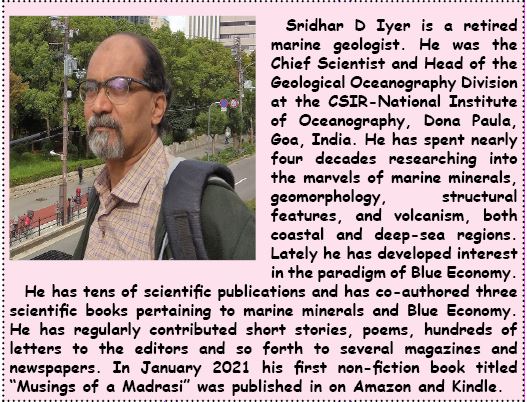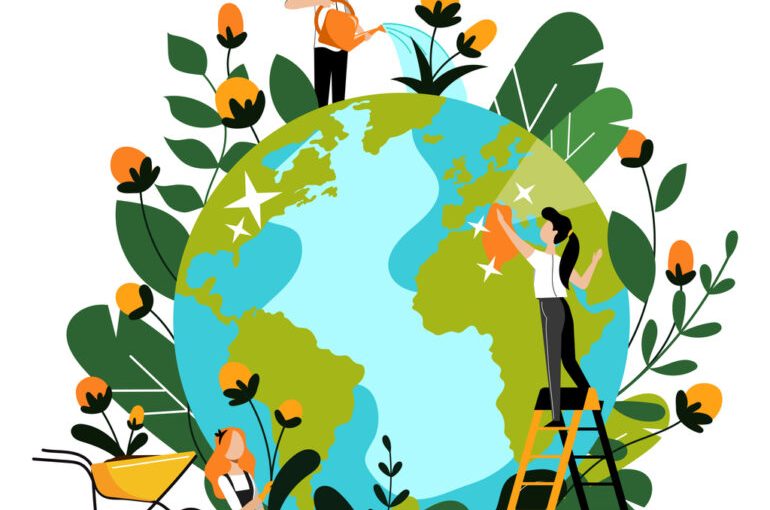Here are various ways in which all of us can adopt a more sustainable lifestyle, observing the motto of — “Reduce, Reuse, Recycle & Refuse.”
By Sridhar D Iyer
What is “sustainable living?”
Sustainable living’ (SL) helps to cut down our dependency on scarce and limited resources of Mother Earth such as her flora, fauna, water, fossil fuels and more. SL would lead to less purchase, consumption and wastage, and boost the use of renewable energy. Our healthier choices could halt the rapid depletion of resources and we would be able to leave something for the coming generations. The art of SL (ASL) is not only for our betterment but also for all other life forms on earth. With less pollution and greenhouse gases would result in cleaner seas, oceans and forests. Through ASL, carbon footprints could be reduced and result in a positive impact on the environment.
Perhaps the 1962 book “Silent Spring” by Rachel Carson, an American marine biologist, naturalist and environmentalist, gave an impetus to the concept of sustainability. The book tackled the toxic effects of pesticides and fertilisers on wildlife and, in 1970, supposedly led to the formation of the US Environmental Protection Agency.
In the early 1980s, the UN formed the World Commission on Environment and Development to unite nations to collaborate and pursue sustainable development. The 1987 report “Our Common Future” by the UN-mooted SL by introducing steps such as recycling and renewable energies. In 2015 the UN mooted the Paris Agreement which was a legal treaty between global leaders to help reduce climate change. This was followed by UN’s updated 17 Sustainable Development Goals.
Art of Sustainable Living
In our own small ways we can protect the environment and make for ourselves and others a congenial living place.
Water: 75% of our earth is composed of water, but most of it is salty and present as seas and oceans. Globally, freshwater resources are depleting for various reasons. The major source of freshwater is locked in the polar regions and these may not melt in our life time. Hence, using water wisely for drinking, cooking, gardening and other chores will help; apart from washing together all the vegetables that you plan to cook and using the water for the plants. Waste water from bungalows and buildings could be collected and treated to water the gardens, to wash vehicles and other surroundings. There is a thought that the next world war could be for water! We need to preserve and sensibly use water and safeguard the water-bodies.
Food: Agriculture, animal husbandry and dairy farming are the mainstays of any country. All these contribute to greenhouse gases, but that from animal rearing is very significant, apart from lingering issues like deforestation and polluted water. Once or twice a week, non-vegetarians could become vegetarians, while vegetarians could become vegan. In the beginning, this may be difficult but it could gradually become a habit. Eating healthy by including more greens and fruits, while also decreasing sugar, salt and oils contents also play a key role in SL. Many people tend to buy more ingredients than needed for cooking, or order unnecessary amounts of food. Hence, it is necessary to make or order only what we can consume.
The extra food left over could be used the next day to make a new dish, given to the hungry, or composted at home to get rich organic fertiliser. Before wasting food, think of the millions of people who do not even get a single decent meal a day. The US Food & Drug Administration has estimated that 30-40% of food goes waste nationally. In 2015, Americans threw out 6,300 crore kg (133 billion pounds) of food! This could have fed the world’s population for several years.
Go organic: As in the past, before the advent and extensive use of commercial fertilisers, insecticides and pesticides, many countries are turning to organic materials to grow and protect crops, vegetables and fruits. These produce have more nutrients and less toxic contents, such as heavy metals, than those grown using man-made chemicals.
Ironically, for some reason, organically produced food is always expensive! Perhaps this is a marketing strategy by corporates selling fertilisers and other farm-related materials to dissuade people from buying organic produce, as many would buy organic produce if prices are lowered. Having a home or garden kitchen where you can grow vegetables by utilising home-made compost is another innovative solution.
Home and personal care-products: Trying to prepare your own personal-care and home products such as soaps, shampoos, face masks, scrubs, candles, incense sticks, etc, are a viable idea too These activities could help save money, keep oneself busy and one could even sell or gift these items.
Energy: Using LED bulbs, though a little pricey, that have a longer life than the tungsten filament types can help in energy conservation, aside from buying energy-efficient appliances such as air-conditioners, cloth and dish washing machines. As a tropical country, India receives ample sunlight during most days of the year; this could be tapped for our homes, buildings or workplaces. The cost of setting up solar panels could be high depending on our energy consumption and other factors, but the long-term savings on electricity bills present as an attractive proposition. You could even sell the excess energy produced to the government!
Transportation: Two of the best ways to stay mobile is walking and cycling! Both are excellent ways to stay fit but most times it may not be possible due to distance, traffic and time. But walk or cycle whenever possible and also prefer to climb stairs even if there are elevators and escalators present. Using public transport, carpooling with friends and colleagues, and riding e-bikes aid in reducing greenhouse emissions.
Go-green: In most states, due to concretisation of towns and cities, trees and hills have disappeared rapidly. There are hardly any efforts to create and maintain green lungs in the form of gardens and parks. Development is needed but in the long run such wanton building up every opens pace mindlessly will lead to environmental pollution and lead to climate change, flooding, landslides, drying of ponds and lakes, and migration of birds and animals. Will this make any of us happy?
We may compensate loss of trees by planting saplings and trees in our neighbourhood and donating to afforestation initiatives. During the day, because of vegetation, humans and animals get sufficient life-saving oxygen, while during the night even vegetation competes for oxygen in the atmosphere. We must grow and care for our green warriors which are majorly, trees.
Shopping: Everyone likes to shop for clothes, foods, trinkets and so forth. Shopping wisely by not buying what you already have, or buying excessively simply because the prices are attractive or there is an on-going sale, must be resisted. Clothes not used for long periods of time or improperly stored may not fit you anymore and may be moth-eaten. Instead, we may gift them to various charities, thrift stores or jumble sales. Take to more environment friendly “ethical” fashion by buying cotton and khadi clothes, and shun fast fashion if you can! Shun apparel and footwear made from animal hides and birds’ feathers. These animals of the wild do not use or harm us, so why should we destroy them to use them? Inculcating the practice of buying second-hand clothes helps, if you are comfortable wearing them. Shop for what you need and not what is offered “free” or as “gifts” that come along with the product. There is no free meal in the world!
Avoid plastics: This is easier said than done! There was a time when people used to carry cloth bags for shopping. The grocers used to pack sugar, pulses, rice, etc, in newspapers twisted in the form of a cone and tied with a string. Milk bottles were in vogue, people carried utensils to procure milk and oil from vendors. Water was stored in large vessels for use.
Once our plastic world crept in it overtook everything and it is the biggest menace causing pollution. Plastics do not decompose and take years to degrade, they end up as macro and micro-plastics in fresh-water water bodies, affecting water quality in seas and oceans, it is injurious to innocent marine life, or it goes into landfills which may catch fire and result as toxic smoke in the air. Drainages get clogged with plastics and lead to flooding during the monsoon months.
Many countries have either banned or restricted manufacturing and sale of plastics. Avoid or minimise plastic usage in its various avatars, especially single-use plastics viz, bags, cups, bottles and containers.
Spread the word: Follow the principle of “Each One, Teach One,” and spread the message about the Art of Sustainable Living to family, friends and youngsters. Do grab the opportunities to give a talk or write about ASL in social and print media. Create awareness among as many people that you can, but do not compel or expect them to follow ASL to the tee. Not everyone would be keen to do so for reasons they know best. As every drop makes an ocean, in the long run, so may your words and personal examples about ASL to enthuse and inspire others. The aforementioned ways to practice the art of sustainable living or lifestyles are not exhaustive and it is left to individuals to improvise as per requirement, style of living and affordability.
Advantages of ASL
There are several paybacks for us and a safer liveable environment results on practicing ASL.
Health: Walking, exercising, eating healthy and maintaining a timetable for our activities would increase our fitness and immunity to common illnesses and diseases
Cost cutting: ASL could result in saving our hard-earned money which could be put to a better use. The reduced spending could be due to using renewable energy and less electricity, travelling by public transport, trimming expenses on foods, and consuming them only to the extent needed, avoiding plastics, and in several other ways.
Judicious use of resources: We could conserve resources by prudent buying of necessities, rainwater harvesting, recycling water and so on. By foregoing or being less reliant on air-conditioners and heaters, and using natural light to the extent possible could lead to nil or reduced waste and utility bills.
4Rs: We are familiar with the 3Rs – Reduce, Recycle and Reuse. Add the 4th R – Refuse. We could refuse plastics, extra food and drinks, free rides in various ways. There are quite simply so many ways in which we may and can execute ASL in our day-to-day routine and even come up with our very own unique ideas to be friend to the good earth which is first and primary home!
It may be difficult to adopt ASL in a short span of time, but do try and implement it slowly and steadily. After a few days, ASL would become second-nature and you will enjoy the new ‘you’ and reap the benefits – health-wise and money-wise. Indirectly, this ASL will favour the flora and fauna and in the process, lead to an eco-friendly environ. The motto should be, “Leave your green imprint for posterity, and not enhanced carbon footprints for future generations!”

